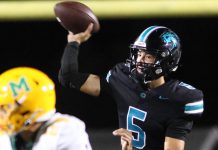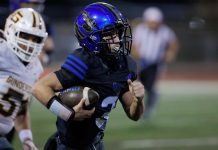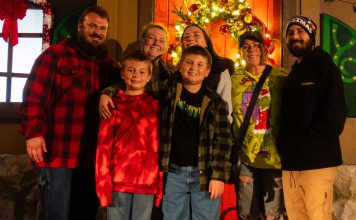Let the record show, when he was growing up in Hollister, Don
Castro never stirred images of Johnny Strabler.
By Andrew Matheson Staff Writer
Let the record show, when he was growing up in Hollister, Don Castro never stirred images of Johnny Strabler.
The rebellious leather-jacket-wearing leader of the pack that was portrayed by Marlon Brando in the 1953 film, “The Wild One,” Strabler was usually seen causing trouble and running from the police in and around Hollister, where the film was shot.
Castro, born and raised in Hollister, could be seen back in the mid-1960s racing around the streets of his hometown on his Honda 90cc motorcycle, nothing like the big, bad biker gangs of Hollywood film making.
Looking back, though, racing in the streets of Hollister was simply the beginning of Castro’s career.
“I started racing around the streets and got into trouble,” said Castro, who admitted he didn’t own a leather jacket. “Hollister was just a small town. (The police) would just go to my dad. They didn’t chase after me.”
As a result, Castro’s father purchased him a Triumph 500cc, with the deal contingent that Castro remained on a track, and off of the streets.
For Castro, it was a no-brainer.
“That’s how it all started … There was always an attraction (to motorcycles),” said Castro, whose first job was on a bicycle delivering newspapers. “I didn’t like pedaling. I’d rather use a throttle.
“And right away, I just started winning races. I had a natural ability.”
Before entering the amateur ranks of motorcycle racing, and eventually turning pro, Castro started racing dirt tracks, and he won the first event he competed in.
“It’s about the competition,” Castro said. “It was something I was good at. Naturally, if you’re good at something, you end up doing it.”
The ride for Castro nearly ended before it even began, however.
At Chowchilla Fairgrounds, at the age of 16, Castro was thrown off his bike during the race, and proceeded to get run over by competitors. He broke his sternum, some ribs, his leg, and an ankle and an arm, among other things.
It took six months to recover, and for a 16-year-old at the amateur novice level, Castro began to think about getting away from motorcycles.
But he didn’t.
“I just love doing it,” he said. “Once you healed up, there wasn’t really any pain. You forget about pain real quick.”
It turned out Castro made the right decision. He went from a junior to an expert in one month after his injuries, and entered the professional ranks at 18 years of age.
Castro began winning so much, that as a professional novice, he was ranked No. 1 Indoor California (short track racing) and No. 5 in the nation through the American Motorcyclist Association.
In 1969, now as a junior pro, Castro won seven of 24 Grand Nationals, top-draw races that brought the best talent in motorcycle racing, and he was ranked the No. 2 junior.
Racing along with the best, Castro signed with Triumph for a full contract, which included salary and paid expenses. Back then, Triumph provided the bikes as well, but the racers, for the most part, made the modifications.
David Cascio of Hollister, who owns South County MX in Gilroy, grew up watching Castro race in San Jose and Laguna Seca, and has developed a relationship with the storied racer for the past 13 years.
“He was one of the fastest dirt-track racers in the sport during his time,” Cascio said. “He could do a lot of stuff with a motorcycle that a lot of good racers couldn’t do.
“Nowadays, the riders just ride. In the old days, you did everything yourself or helped out, and Donny was real sharp when it came to motors.”
Castro’s motor-modifying came in handy one race, but also came with a cruel twist. After Triumph folded, leaving Castro as a privateer without a sponsor, he traveled down to the Houston Astrodome for a Grand National. His van was stolen, however, leaving him bikeless.
After making a few calls, he found a bike, modified the engine within two days, and went out and took first in his heat at the Astrodome. His luck ran out there, though, as in the final, the engine broke.
Things changed for Castro in 1973, however, when he signed with Yamaha and was part of their racing team. It was a “full-fledged team,” he said. That year, Castro’s Yamaha teammate, Kenny Roberts, finished No. 1 while Castro finished No. 5, tying the highest ranking he had as a professional.
Castro “retired” at the end of his term with Yamaha in 1977, as he needed three more operations on his right leg. He worked at Hollister Hills State Vehicular Recreation Area and now runs a motorcycle shop in Tres Pinos called Racer’s Edge.
“I was always in too much pain,” Castro said. “We use to have conversations with Evel Knievel and talk about who broke more bones – him or us.”
Castro returned for a few races, and in 1993, BMW began the Battle of the Legends series, which pitted Castro and 10 other legends in exhibition races all over the country. It lasted until 1997.
In 2005, his most previous track run, Castro raced for the last time. For now.
Castro, 57, now modifies and works on motorcycles in Tres Pinos. When he was with Yamaha, though, instead of working on modifications – Yamaha took care of that – Castro was, as what he calls, “a PR person.”
“They were a true race team,” he said. “I was supposed to wear a suit and a tie and do PR work.”
The media knew Castro was from Hollister, and they wanted to know when “The Wild One’s took over Hollister.”
“We were trying to change that image,” Castro said.
Unlike “The Wild One,” which was banned from the United Kingdom on its release, Castro was never banned from the UK, even after the incident in 1971 with Triumph in Europe.
“We didn’t know how to drive, so they hired riders with Rolls Royce,” Castro said. “So we took the Rolls out on the race track to try learning the course. Well, we’re all racing each other … and we accidentally rolled it over … That was the start of our European racing.”
Despite the broken bones and surgeries, Castro said, “I’d do it the same all over again.”












